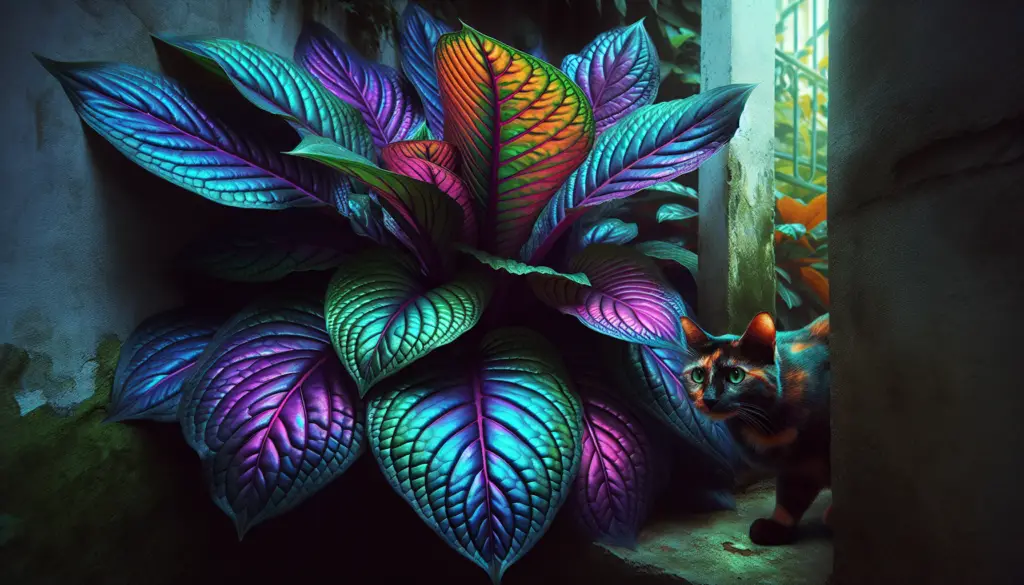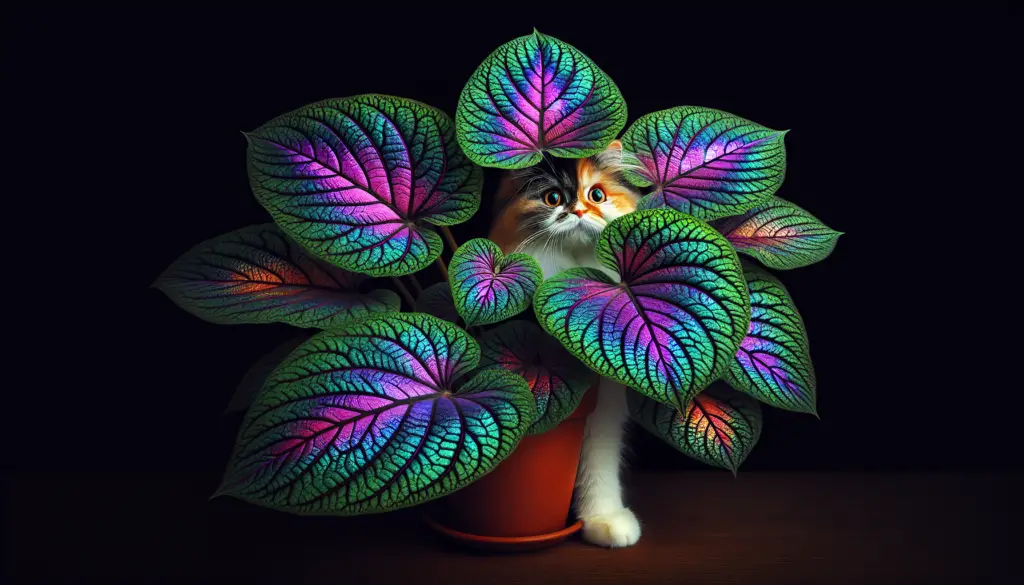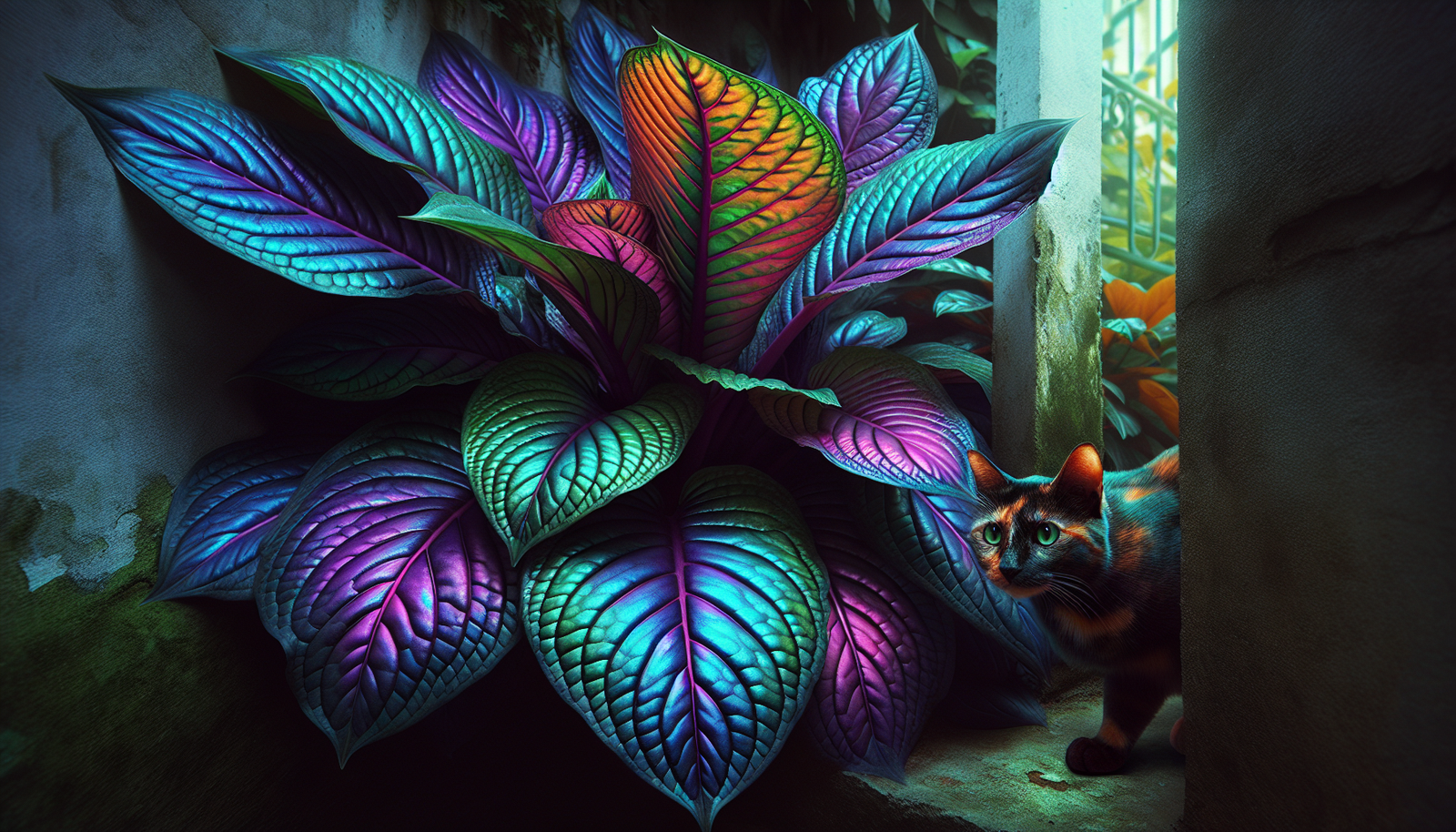If you’re a cat owner and considering adding the stunning Persian Shield plant to your home, you might be wondering: Are Persian Shield plants toxic to cats? This captivating article will explore the potential risks associated with these vibrant plants and provide you with the information you need to keep your furry friend safe. With its luscious purple leaves and striking appearance, the Persian Shield plant has gained popularity among plant enthusiasts, but it’s crucial to ensure the safety of your feline companion before introducing this plant into your living space.
Overview of Persian Shield Plants
Persian Shield Plants (Strobilanthes dyerianus) are known for their striking foliage, making them a popular choice among gardeners and plant enthusiasts. With their vibrant purple leaves and iridescent shimmer, these plants can add a touch of exotic beauty to any landscape. However, when it comes to the safety of our feline friends, it is crucial to delve deeper into the potential risks that Persian Shield Plants may pose to cats.
Description of Persian Shield Plants
Persian Shield Plants are herbaceous perennials that typically reach a height of two to three feet. They have large, lance-shaped leaves that are known for their deep purple color and metallic sheen. The undersides of the leaves are usually a vibrant shade of pink. This unique combination of colors makes Persian Shield Plants a visually stunning addition to any garden or indoor space.
Origin and Distribution
Native to Myanmar (Burma) and the neighboring regions of Malaysia and Thailand, Persian Shield Plants thrive in tropical and subtropical climates. However, they can also be cultivated as houseplants in areas with colder climates. Due to their popularity, they have been widely distributed around the world and can now be found in various regions across the globe.
Common Uses in Landscaping
Persian Shield Plants are highly valued for their ornamental qualities and are often used as focal points in landscaping projects. They can be incorporated into both indoor and outdoor spaces, adding texture, color, and visual interest to gardens, borders, and containers. Their striking foliage pairs well with other plants of contrasting colors, creating stunning displays and vibrant landscapes.
Characteristics of Persian Shield Plants
Aside from their eye-catching appearance, Persian Shield Plants have several noteworthy characteristics. They are relatively low-maintenance and can tolerate a range of light conditions, although they thrive in bright, indirect sunlight. These plants are also known for their ability to withstand high humidity levels, making them ideal for tropical or humid environments. While they are not particularly drought-tolerant, they do require well-draining soil to prevent root rot.
Cats’ Natural Curiosity
Cats are naturally curious creatures, always on the lookout for new objects and experiences to investigate. Their inquisitive nature often leads them to explore their surroundings, including the plants in their environment. This curiosity may be harmless in many cases, but it can occasionally expose them to potential dangers, such as toxic plants.
Inquisitive Nature of Cats
It is no secret that cats are notorious for their curiosity. From chasing shadows to investigating every corner of the house, they possess an innate desire to explore their surroundings. This curiosity extends to plants as well, as they are naturally drawn to the textures, scents, and movement that plants offer. Unfortunately, this curiosity can unwittingly lead them to toxic plants, putting their health at risk.

Tendency to Investigate Plants
Cats often exhibit a keen interest in plants, whether they are indoors or outdoors. They may rub against them, chew on leaves, or even attempt to play with them. While this behavior may seem harmless, it is essential to remember that cats are obligate carnivores and lack the digestive enzymes necessary to break down certain plant compounds. As a result, their exposure to toxic plants can lead to significant health issues.
Plant Toxicity to Cats
Understanding the potential toxicity of plants is crucial for pet owners. While many plants are harmless to cats, there is a range of toxic plants that can cause severe health problems. Persian Shield Plants fall into the category of plants that can be toxic to our feline companions.
Understanding Toxicity Levels
Toxicity levels can vary among plants, and it is essential to distinguish between plants that are mildly toxic, moderately toxic, or highly toxic to cats. Persian Shield Plants are considered to be moderately toxic to cats, meaning that ingestion can cause adverse effects on their health.
Potential Health Risks to Cats
When cats come into contact with or ingest Persian Shield Plants, they may experience a range of health risks. These risks can vary depending on the cat’s overall health, the amount of plant material consumed, and the cat’s size. It is crucial to monitor cats closely if they have access to Persian Shield Plants to ensure their well-being.
Signs and Symptoms of Plant Poisoning
Recognizing the signs and symptoms of plant poisoning is essential for early detection and prompt treatment. If a cat has been exposed to or ingested Persian Shield Plants, the following signs and symptoms may occur:
- Gastrointestinal distress, including vomiting and diarrhea
- Respiratory issues, such as coughing or wheezing
- Neurological effects, such as lethargy or seizures
- Dermatological reactions, including skin irritation or rashes
Toxic Substances in Persian Shield Plants
To fully understand the potential dangers that Persian Shield Plants pose to cats, it is important to identify the toxic compounds present in these plants and how they affect feline physiology.
Identification of Toxic Compounds
Persian Shield Plants contain several toxic compounds, including saponins and flavonoids. These compounds can have adverse effects on cats’ gastrointestinal, respiratory, and nervous systems when ingested or absorbed through the skin.

Effects on Feline Physiology
When a cat ingests or comes into contact with Persian Shield Plants, the toxic compounds present can disrupt normal physiological processes. The gastrointestinal tract, respiratory system, and nervous system are particularly vulnerable, leading to various health issues.
Factors Influencing Toxicity
Several factors influence the potential toxicity of Persian Shield Plants to cats. These factors include the dose and exposure, the size and health condition of the cat, and any pre-existing sensitivities the cat may have.
Dose and Exposure
The amount of Persian Shield Plant material ingested or the intensity and duration of contact can significantly impact the level of toxicity experienced by a cat. Higher doses or prolonged exposure increase the risks to their health.
Cat’s Size and Health
The size and overall health condition of the cat are factors that influence their susceptibility to plant toxicity. Smaller cats and those with compromised health may be more susceptible to adverse effects.
Pre-existing Sensitivities
Some cats may have pre-existing sensitivities or allergies that make them more susceptible to the toxic compounds present in Persian Shield Plants. It is crucial to be aware of any known sensitivities or allergies your cat may have when assessing the potential risks.
Specific Dangers of Persian Shield Plants
The specific dangers of Persian Shield Plants’ toxicity lie in their potential to cause harm to cats. Understanding these dangers is crucial for pet owners to ensure the safety and well-being of their feline companions.
Toxicity Potential
As moderately toxic plants, Persian Shield Plants can cause a range of health issues when ingested or when direct contact is made. The severity of these effects can vary depending on the amount ingested and the individual cat’s sensitivity.
Common Routes of Exposure
Cats can come into contact with Persian Shield Plants through various routes, including ingestion, inhalation of pollen or dust particles, and direct skin contact. Each of these routes has the potential to lead to toxic effects.
Toxic Parts of the Plant
The leaves and stems of Persian Shield Plants contain the highest concentration of toxic compounds. Cats that chew on the leaves or come into contact with any broken plant parts are at a higher risk of toxicity.
Symptoms of Persian Shield Plant Poisoning in Cats
Recognizing the symptoms of Persian Shield Plant poisoning is essential for providing prompt care and seeking veterinary assistance. If you suspect your cat has been exposed to this toxic plant, watch for the following symptoms:
Gastrointestinal Distress:
Cats may experience vomiting, diarrhea, and abdominal discomfort after ingesting Persian Shield Plants. These symptoms may manifest within a few hours of exposure and can range from mild to severe.
Respiratory Issues:
Inhalation of pollen or dust particles from Persian Shield Plants can lead to respiratory issues in cats. Coughing, wheezing, or difficulty breathing may be observed.
Neurological Effects:
Toxic compounds in Persian Shield Plants can affect the cat’s nervous system, leading to lethargy, disorientation, seizures, or even coma. Any abnormal behavior or neurological symptoms should be taken seriously.
Dermatological Reactions:
Direct skin contact with Persian Shield Plants can cause irritation, redness, and rashes in cats. If you notice any changes in your cat’s skin after contact with this plant, it is crucial to seek veterinary advice.
Emergency Measures for Persian Shield Plant Poisoning
If you suspect that your cat has been exposed to or ingested Persian Shield Plants, taking immediate action is vital. Contacting a veterinarian and following initial first aid steps can help mitigate potential risks and ensure the well-being of your cat.
Contacting a Veterinarian:
Consulting a veterinarian is crucial in cases of plant poisoning. They can provide guidance on the appropriate next steps and advise if further medical attention is necessary based on the severity of symptoms or exposure.
Initial First Aid Steps:
If you believe your cat has ingested Persian Shield Plants, it is essential to remove any remaining plant material from their mouth to prevent further ingestion. Gently rinse their mouth with water and offer small amounts to drink to help dilute any toxins.
Avoiding Home Remedies:
While home remedies may seem tempting, it is essential to avoid using them without professional guidance. Some substances may worsen the cat’s condition or interact negatively with the toxic compounds present in Persian Shield Plants.
Diagnostic and Treatment Procedures:
A veterinarian will conduct a thorough examination of your cat, which may include blood tests, X-rays, or other diagnostic procedures to assess the extent of toxicity and determine the most appropriate treatment. Treatment options may include supportive care, decontamination, or administration of specific medications.
Prevention and Safety Measures
Prevention is always better than a cure when it comes to protecting our cats from potential plant toxicity. By implementing proper safety measures and creating a cat-friendly environment, pet owners can reduce the risks associated with Persian Shield Plants.
Removing Persian Shield Plants from the Environment:
The most effective way to prevent plant toxicity is to remove Persian Shield Plants from areas accessible to your cat. This eliminates the risk of exposure and ingestion.
Secure Indoor and Outdoor Environments:
If Persian Shield Plants are part of your indoor or outdoor landscaping, ensure that your cat’s access to these areas is restricted. Use barriers or designated play areas to prevent accidental contact.
Cat-Friendly Alternatives:
Explore cat-friendly alternatives to Persian Shield Plants that are safe for your feline companion to interact with. There are numerous plant options available that can provide similar visual appeal without the associated toxicity risks.
Education and Awareness:
Increasing awareness about the potential dangers of Persian Shield Plants and other toxic plants among cat owners and the general public is crucial. Proper education can help prevent accidents and ensure the well-being of our beloved feline friends.
Common Non-Toxic Alternatives for Cats
To provide a safe and enriching environment for your cat, consider incorporating non-toxic plants into your home or outdoor space. The following list provides some examples of cat-safe plants:
- Spider Plant (Chlorophytum comosum)
- Boston Fern (Nephrolepis exaltata)
- Areca Palm (Dypsis lutescens)
- Bamboo Palm (Chamaedorea seifrizii)
- African Violet (Saintpaulia)
- Catnip (Nepeta cataria)
These non-toxic alternatives can offer a visually appealing and non-threatening environment for your cat to explore and enjoy.
In conclusion, while Persian Shield Plants may be a mesmerizing addition to any landscape, their potential toxicity to cats cannot be overlooked. Understanding the risks, signs, and symptoms of plant poisoning is essential for any cat owner. By implementing preventive measures and creating a cat-friendly environment, we can ensure the well-being and safety of our feline companions.

